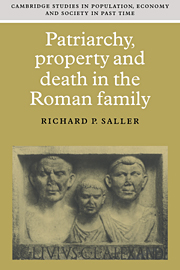Book contents
- Frontmatter
- Contents
- List of tables
- Preface
- Abbreviations
- 1 Introduction: approaches to the history of the Roman family
- Part I Roman life course and kinship: biology and culture
- Part II Roman family and culture: definitions and norms
- Part III The devolution of property in the Roman family
- 7 Strategies of succession in Roman families
- 8 Guardianship of Roman children
- 9 Dowries and daughters in Rome
- 10 Conclusion
- Bibliography
- Index
- Cambridge Studies in Population, Economy and Society in Past Time
9 - Dowries and daughters in Rome
Published online by Cambridge University Press: 23 November 2009
- Frontmatter
- Contents
- List of tables
- Preface
- Abbreviations
- 1 Introduction: approaches to the history of the Roman family
- Part I Roman life course and kinship: biology and culture
- Part II Roman family and culture: definitions and norms
- Part III The devolution of property in the Roman family
- 7 Strategies of succession in Roman families
- 8 Guardianship of Roman children
- 9 Dowries and daughters in Rome
- 10 Conclusion
- Bibliography
- Index
- Cambridge Studies in Population, Economy and Society in Past Time
Summary
Dowry was an institution of legal, economic and social dimensions that Roman fathers and mothers used to transmit property and status to their daughters. Although legitimate marriage in Roman law did not require validation by a dowry, the provision of one was a paternal duty (officium patemum) enforced by social expectation and law among the propertied classes. Like a creditor who automatically expected repayment of a debt, a husband expected payment of a dowry, “ since he would not take a wife without one (indotatam uxorem)” (Dig. 42.8.25.1, Venuleius). Since lack of a dowry could effectively prevent a woman of the propertied classes from entering marriage, Augustus legislated against fathers who tried to stop a daughter's marriage by refusing to finance a dowry. My aim in this chapter is not to repeat the recent systematic treatments of the legal rules and other evidence for dowries. Rather, I wish to examine dotal exchange within the Roman legal and demographic context as one element related to others in the devolution of familial property. Although no systematic evidence for dowries is available, and the scattered testimony points in various directions, it may be possible to generalize beyond the assertion that “almost everything about Roman dowry is ambivalent.”
As one element in the devolution of property before the death of the parents, dowries in historical societies have varied in function and size – so much so that it could be argued that “dowry” as a catch-all category is misleading.4 Since dos is a specific category in Roman law, even though dowries could differ widely in size and purpose, it does not seem sensible to drop it from the analysis.
- Type
- Chapter
- Information
- Patriarchy, Property and Death in the Roman Family , pp. 204 - 224Publisher: Cambridge University PressPrint publication year: 1994



